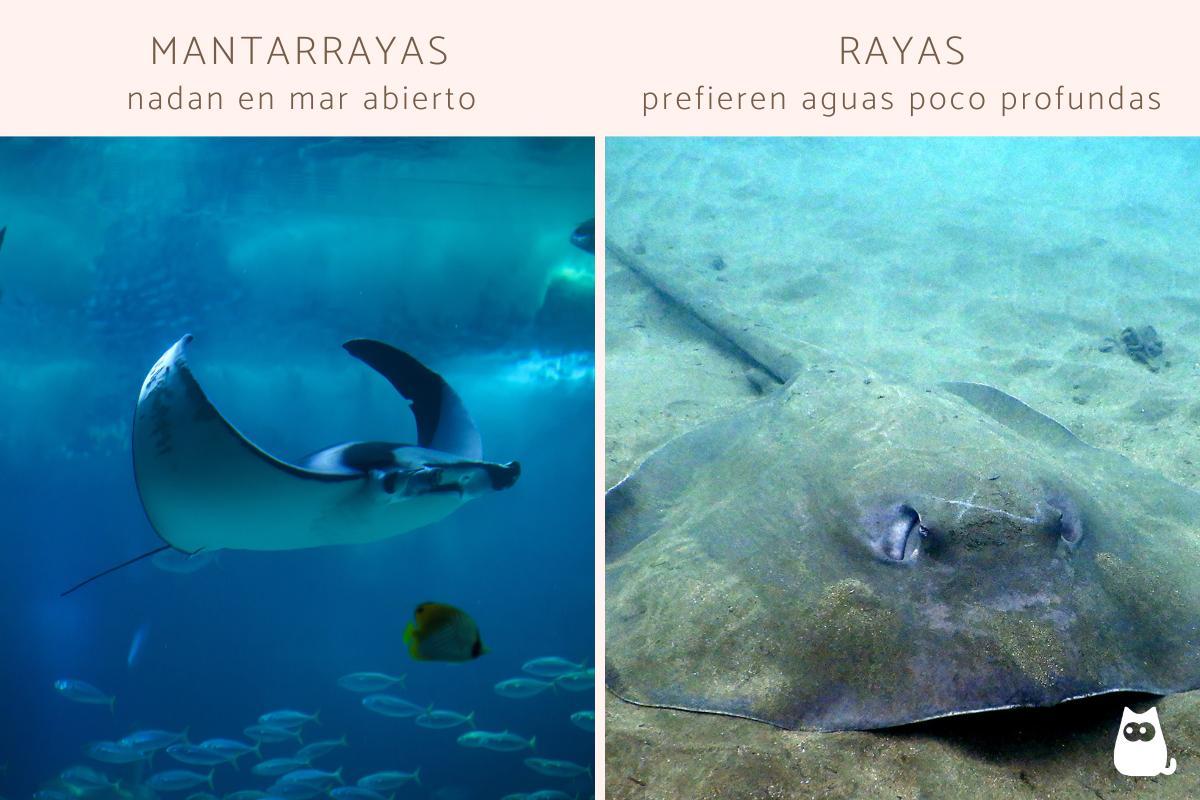Differences Between Manta Rays and Stingrays


Despite being very differently shaped to most others, rays are a type of fish. Their flat body appears as if it is all fin, a morphology partially afforded by the fact they are cartilaginous. Having a boneless body with tough, but malleable cartilage allows them to move in a way other fish don't. While they do have large pectoral fins, they move in such a way that rays swim in an undulating motion in the water. This is unique among fish, but not all rays are the same. They have different shapes, behaviors and other characteristics.
AnimalWised looks at the differences between manta ray vs. stingray to better understand why rays are so special. We look at their physical and behavioral differences, as well as provided photos to better illustrate them.
Are manta rays and stingrays the same animal?
Due to their similarities in body shape, it is easy why some of us may wonder if stingrays and manta rays are the same species. Despite being of the same superorder known as Batoidea, they are not the same species. They are not even of the same order. They both belong to the Elasmobranchii subclass, a taxonomic class which also includes all the different types of shark.
Manta rays and stingrays share several characteristics, such as their skeleton made of cartilage instead of bone, but they belong to different taxonomic classifications with their own distinct biological and ecological adaptations. Let's get to know them:
- Stingrays: these are part of the suborder Myliobatoidei, a type of ray usually found in tropical and subtropical marine waters. However, there are also freshwater stingray species. There are around 220 known stingray species which are encapsulated by various families, often distinguished by their shape. They are more numerous in number of species and overall diveristy than manta rays.
- Manta rays: part of the order Myliobatiformes, they are not a suborder like stingrays. They are actually a subgenus of the genus Mobula, encompassing many fewer species than stingrays. In terms of evolution, it is believed that manta rays separated from stingrays millions of years ago, developing characteristics and lifestyle habits that allow them to occupy different ecological niches.
At first glance of the photos below, both stingrays and manta rays may seem very similar due to their flattened bodies, important adaptations for life in the ocean. A more detailed analysis of their morphology, behavior and distribution shows they are two very different groups. This applies to both their biology and their relationship with the environment which makes up their natural habitat.
Despite being part of the same subclass, you can see how sharks and rays are different with our article on shark anatomy.

Differences between stingrays and manta rays
As we can see, there are key taxonomic difference between manta rays vs. stingrays. The reasons for this is because they have diverged in their evolution, resulting in important differences in their characteristics. They include:
Body size and shape
One of the most obvious differences between rays and manta rays is size. Manta rays are larger than stingrays, with the largest species being the giant oceanic manta ray (Manta birostris) which can reach a wingspan (disc size) of over 23 ft (7 m) and weigh up to 6,600 lb (3,000 kg). This makes them the largest of any ray species and second only to the whale shark in Elasmobranchii.
Stingrays are most often considerably smaller. Most stingray species are between 1.6-6.5 ft (0.5-2 m) wide, although some species such as the southern stingray (Hypanus americanus) can reach over 3 metres, but these are rare exceptions.
In terms of body, manta rays have a rhomboid shape with long and pointed pectoral fins. Coupled with their size, these give them a majestic appearance while swimming. These fins are adapted to allow them to perform acrobatic movements and travel long distances in the open ocean. In comparison, stingrays have a more circular body shape, with shorter fins that allow them to move easily along the seabed. They tend to be benthic animals, meaning they live close to the seabed.
Feeding behavior
Another crucial difference between rays and manta rays is how they eat. Manta rays are filter feeders, meaning they feed on small organisms floating in the water. These include plankton, fish larvae and small crustaceans. To capture their food, they swim with their mouths open while filtering water through their gills. These gills are adapted with specialized structures to retain the plankton. Some manta rays also have cephalic lobes, i.e. projections on either side of their head that help them direct food into their mouths as they swim.
In contrast, stingrays are primarily bottom feeders. They have a more varied diet that includes mollusks, crustaceans and small fish. They use specialized sensory organs to locate prey buried in the sediment. Their powerful jaws allow them to crush hard shells to access the meat inside. This type of feeding is closely related to their benthic habitat, as they usually hunt and feed while staying close to the seabed.
Tails and defense mechanisms
A seen in the photos, tails are one of the most obvious traits that distinguishes manta rays from stingrays. Stingrays are known for having long and thin tails that are often equipped with venomous stingers. These stingers are used as a defense mechanism against predators and can cause painful wounds to humans if they accidentally step on or touch them.
The toxin released by a stingray's stinger can lead to swelling, intense pain, and in extreme cases, infections or more serious medical complications. The sting itself can also kill if they strike their prey in the right place. Despite the common name, not all stingrays have stingers, but most do.
In contrast, manta rays have shorter tails and lack venomous stingers. While some species do have stingers, they do not contain venom and are not used as an active defense mechanism. Manta rays rely more on their size and speed to escape predators, although they actually have few natural enemies due to their large size.
Discover more about the threats these animals can provide with our article asking how dangerous are stingrays really?

Other differences between manta ray vs. stingray
While the physical differences detailed above can be some of the most stark, the habitats and behaviors of these two ray species also set them apart. They include differences in:
Habitat and behavior
Stingrays and rays occupy different types of habitats:
- Stingray habitat: they are mostly benthic animals and prefer to live in shallow waters near the bottom of the ocean where they can hide in sand or mud, as depicted in the photo below. This behavior allows them to camouflage themselves from predators and also makes it easier to hunt their prey. Some species of rays also inhabit freshwater rivers and lakes, being animals adaptable to different aquatic environments.
- Manta ray habitat: they are pelagic, meaning they spend most of their lives in the open ocean, far from the seabed. They tend to swim near the surface and migrate, covering great distances in search of food. They may sometimes approach coral reefs or coasts to clean their skin at cleaning stations, places where small fish eat the parasites accumulates on their bodies. In general, they are more oceanic and mobile animals than stingrays.
Reproduction
Another major difference between stingrays vs. manta rays is in terms of reproduction. While both carry out internal fertilization, stingrays are mostly ovoviviparous animals with embryos that develop in eggs inside the mother's body until they hatch internally, giving birth to live young. Manta rays are viviparous animals, meaning they give birth to fully developed live young without the need for egg hatching. During gestation, manta ray embryos are nourished not only by the egg yolk, but also by a nutrient-rich substance produced by the mother, similar to a placental feeding process.
This gestation process in manta rays can last more than a year and the babies are born precocial. This means they are fully formed and ready to fend for themselves, even if they remain close to their mother in the early stages of their life. Stingrays have a larger number of newborns in each birth, as their reproductive strategy is more oriented towards survival in a more hostile environment on the seabed.
Learn the differences between internal vs. external fertilization in our related guide.

If you want to read similar articles to Differences Between Manta Rays and Stingrays, we recommend you visit our Facts about the animal kingdom category.
- Jacobsen, I. P., & Bennett, M. B. (2013). A comparative analysis of feeding and trophic level ecology in stingrays (Rajiformes; Myliobatoidei) and electric rays (Rajiformes: Torpedinoidei). PLOS ONE, 8(8), e71348.
https://doi.org/10.1371/journal.pone.0071348 - Knight, K. (2009). How stingrays sense their surroundings. Journal of Experimental Biology, 212(21), ii.
https://doi.org/10.1242/jeb.037374 - Su, G., Li, N., Shen, H., Su, Y., Zhu, Y., Yu, L., & Liu, W. (2022). Swimming near substrates: Stingray self-propelled undulatory simulations. Ocean Engineering, 264, 112495.
https://doi.org/10.1016/j.oceaneng.2022.112495 - Sumikawa, H., Naraoka, Y., Fukue, T., & Miyoshi, T. (2022). Changes in rays' swimming stability due to the phase difference between left and right pectoral fin movements. Scientific Reports, 12(1), 2362.
https://doi.org/10.1038/s41598-022-06394-3








